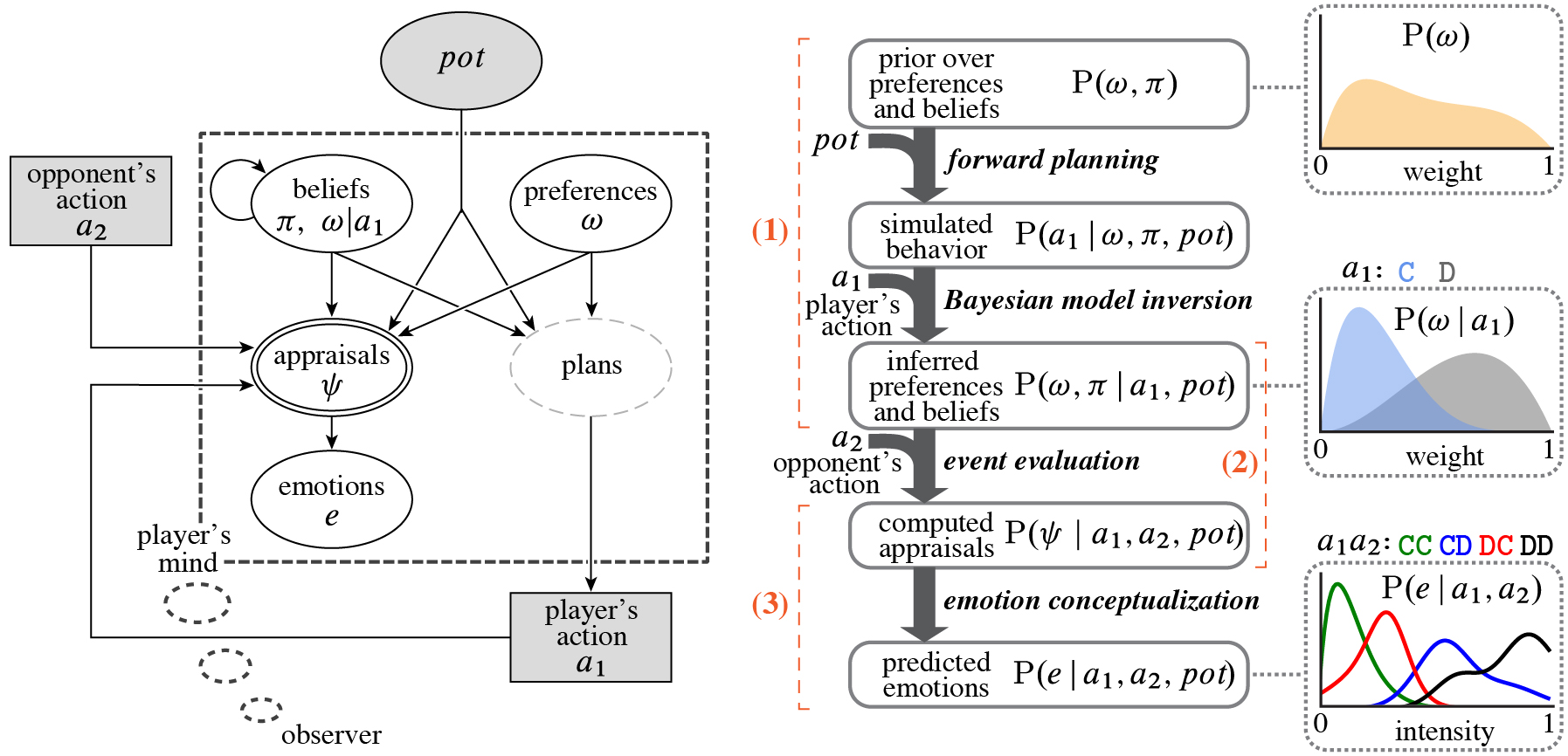ABSTRACT From sparse descriptions of events, observers can make systematic and nuanced predictions of what emotions the people involved will experience. We propose a formal model of emotion prediction in the context of a public high-stakes social dilemma. This model uses inverse planning to infer a person's beliefs and preferences, including social preferences for equity and for maintaining a good reputation. The model then combines these inferred mental contents with the event to compute 'appraisals': whether the situation conformed to the expectations and fulfilled the preferences. We learn functions mapping computed appraisals to emotion labels, allowing the model to match human observers' quantitative predictions of twenty emotions, including joy, relief, guilt, and envy. Model comparison indicates that inferred monetary preferences are not sufficient to explain observers' emotion predictions; inferred social preferences are factored into predictions for nearly every emotion. Human observers and the model both use minimal individualizing information to adjust predictions of how different people will respond to the same event. Thus, our framework integrates inverse planning, event appraisals, and emotion concepts in a single computational model to reverse-engineer people's intuitive theory of emotions.
This work is described in the open access paper.
The GitHub repository (https://github.com/daeh/computed-appraisals) provides all of the raw behavioral data, models, and analyses.
The OSF repository (https://osf.io/yhwqn) provides the cached model data and the behavioral paradigms used to collect the empirical data.
If you use this repository, the data it includes, or build on the models/analyses, please cite the paper (NB citation given in BibLaTex):
@article{houlihan2023computedappraisals,
title = {Emotion Prediction as Computation over a Generative Theory of Mind},
author = {Houlihan, Sean Dae and Kleiman-Weiner, Max and Hewitt, Luke B. and Tenenbaum, Joshua B. and Saxe, Rebecca},
date = {2023},
journaltitle = {Philosophical Transactions of the Royal Society A},
shortjournal = {Phil. Trans. R. Soc. A},
volume = {381},
number = {2251},
pages = {20220047},
doi = {10.1098/rsta.2022.0047},
url = {https://royalsocietypublishing.org/doi/abs/10.1098/rsta.2022.0047}
}code- models and analysesdataIn- raw behavioral data collected from human observers (see the empirical data documentation)dataOut- cached model data (only on OSF)paradigms- mTurk experiments used to collect the behavioral data indataIn/(only on OSF)
To run the computed appraisals model (cam), you can install the dependencies necessary to regenerate the results and figures using a (1) Docker container (2) conda environment or (3) pip specification.
NB Running this model from scratch is prohibitively compute-heavy outside of a High Performance Computing cluster. The model has been cached at various checkpoints to make it easy to explore the results on a personal computer. To make use of the cached model, download and uncompress dataOut-cached.zip. Then place the dataOut directory containing the cached *.pkl files in the local project folder that you clone/fork from this repository (e.g. computed-appraisals/dataOut/) .
Requires Docker. The image includes WebPPL and TeX Live.
NB Docker is finicky about the cpu architecture. The example below builds an image optimized for arm64 processors. For an example of building an image for amd64 processors, see .devcontainer/Dockerfile.
### Clone git repo to the current working directory
git clone --branch main https://github.com/daeh/computed-appraisals.git computed-appraisals
### Enter the new directory
cd computed-appraisals
### (optional but recommended)
### Add the "dataOut" directory that you downloaded from OSF in order to use the cached model
### Build Docker Image
docker build --tag camimage .
### Run Container (optional to specify resources like memory and cpus)
docker run --rm --name=cam \
--memory 12GB --cpus 4 --platform=linux/arm64 \
--volume $(pwd)/:/projhost/ \
camimage /projhost/code/cam_main.py --projectdir /projhost/The container tag is arbitrary (you can replace camimage with a different label).
Requires conda, conda-lock, and a local installation of TeX Live. If you want to run the inverse planning models, you need to have the WebPPL executable in your PATH with the webppl-json add-on.
The example below uses the conda-lock.yml file to create an environment where the package versions are pinned to this project's specifications, which is recommend for reproducibility. If the lock file cannot resolve the dependencies for your system, you can use the environment.yml file to create an environment with the latest package versions. Simply replace the conda-lock install ... line with conda env create -f environment.yml.
### Clone git repo to the current working directory
git clone --branch main https://github.com/daeh/computed-appraisals.git computed-appraisals
### Enter the new directory
cd computed-appraisals
### (optional but recommended)
### Add the "dataOut" directory that you downloaded from OSF in order to use the cached model
### Create the conda environment
conda-lock install --name envcam conda-lock.yml
### Activate the conda environment
conda activate envcam
### Run the python code
python ./code/cam_main.py --projectdir $(pwd)The conda environment name is arbitrary (you can replace envcam with a different label).
If you use a strategy other than conda or Docker to manage python environments, you can install the dependencies using the requirements.txt file located in the root directory of the project. You need to have TeX Live installed locally. If you want to run the inverse planning models, you need to have the WebPPL executable in your PATH with the webppl-json add-on.
Different hardware architectures lead to very small differences in floating point operations. In our experience, setting a random seed causes PyTorch to initialize at the same values, but update steps of the Adam optimizer exhibit minuscule differences depending on the platform (e.g. Intel Xeon E5 vs Intel Xeon Gold cores). As such, rerunning the PyTorch models may yield results that show small numerical differences from the cached data.
